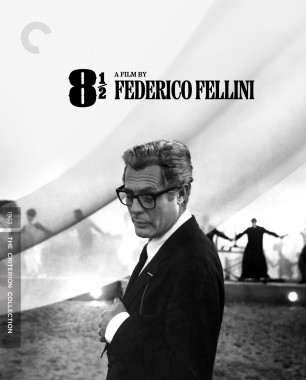
Mary Ellen Mark’s Top10
A celebrated American photographer, Mary Ellen Mark has traveled the world as a photojournalist since the 1960s, published photographs in such magazines as Life, Rolling Stone, the New Yorker, and Vanity Fair, and taken pictures on the sets of over a hundred movies, including Mike Nichols’s Carnal Knowledge, Federico Fellini’s Satyricon and Roma, and Francis Ford Coppola’s Apocalypse Now. She has published eighteen books of photographs over the course of her career. A lifelong cinephile, Mark is particularly inspired by Fellini and Robert Bresson.
-
1
Federico Fellini
La strada
I had the great privilege of working on the sets of Fellini’s Satyricon and Roma. Fellini is for me one of the greatest of all filmmakers—he embraced life with his unique vision and genius. La strada, made in 1954, is the poetic and very moving story of a poor young woman who becomes a clown in a tiny, two-person circus. Her name is Gelsomina. A brutish gypsy, Zampanò, buys Gelsomina from her mother and takes her on the road with him. He trains her to be a clown. She falls in love with him even though he is abusive and cruel. What transpires is a tragic love story with the background of a magical traveling circus. This film surely influenced my interest in and love of the circus.
-
2
Federico Fellini
8½
This beautifully visual film is about a film director, Guido Anselmi, trying to make his latest movie. The film goes back and forth between his memories of his childhood, his fantasies, and his present life. The imagery is iconic and unforgettable—the quintessential Fellini. Who could ever forget the monumental Saraghina dancing on the beach? The images from this film have stayed with me my whole life.
-
3
Federico Fellini
La dolce vita
I saw this film when it first came out in the very early ’60s. It’s a chronicle of a decadent society full of Fellini’s incredibly inventive and imaginative imagery. It’s the story of a Roman journalist struggling between producing something meaningful in his life and drifting along a path of total emptiness. I was very young when I saw the film. I was completely inspired by the combination of such beautiful photography and the sad and powerful story.
-
4
Robert Bresson
Au hasard Balthazar
This film changed my perspective on filmmaking forever. The beautiful and unique imagery and the way music and sound are integrated into the story are completely original. The ending is the best and most poetic I have ever seen. Bresson understands filmmaking in the most economic and profound way. He is as great a filmmaker as Fellini.
-
5
Vittorio De Sica
Bicycle Thieves
This 1948 film is a classic Italian neorealist film that takes place in post–World War II Italy. It is a beautifully told and photographed story about a close relationship between a father, Antonio, and his young son, Bruno, who idolizes his father. As the story opens, Antonio is desperately searching for work and finally gets a job posting signs. In order to do this job, he must have a bicycle. His wife, Maria, pawns her wedding sheets to buy him a bicycle, but it is stolen on the first day of his new job. The rest of the film, father and son pursue the thieves to get the bicycle back. They fail. In the end, Antonio is forced to steal a bicycle so he will not lose his job. Bruno witnesses this and Antonio is humiliated in front of his son. For me, the film was about the ultimate and heartbreaking betrayal of trust between a father and his son. I’ve always photographed families and family relationships. This wonderful film encouraged me to look beyond the surface and find the real relationships that exist between family members. The epic quality of the film was a great inspiration for me.
-
6
Louis Malle
Murmur of the Heart
This film takes place in Dijon, France, in the mid-’50s. It is a coming-of-age film about a boy in his early teens named Laurent Chevalier, who is from a bourgeois family. He has two older brothers who are always teasing him and who introduce him to a prostitute for his first sexual experience. Laurent has a beautiful mother and a successful father who is a gynecologist. After getting scarlet fever and discovering he has a heart murmur, Laurent must stay in bed for several months to recover. When he is better, he travels with his mother to a very fancy resort (sanatorium) in France. The second and third acts of the film are about his coming-of-age experiences at the sanatorium with the other young people who are staying there. It is also about him developing a strong personal relationship with his mother. This film is so daring and touches on many taboo issues—it’s astonishing that it could be made then (1971) and even now it would be considered to be pushing too many boundaries. In the end, it’s a beautiful, deep love story between adolescent children growing up in a privileged life, and about the closest relationship between a mother and son. I wish more films today could push boundaries like Louis Malle did in Murmur of the Heart. This film reassured me how important it is to push boundaries and to pursue issues that are considered by some to be untouchable. It is a truly inspirational film.
-
7
Akira Kurosawa
Ikiru
This is a film about a man’s rebirth. It was made in 1952 and is set in Japan’s postwar rebuilding period. Kanji Watanabe is a man trapped in the dreary bureaucracy of his job and life. When his doctor tells him that he has terminal cancer and a short time to live, he decides to change his life. He first tries going out on the town drinking in nightclubs and spending time with a young woman. This is a beautifully seen relationship that soon ends in disappointment. It is not until several poor women come into his office to complain about the terrible conditions in their slum neighborhood that he realizes how he can give his life meaning. In his quiet way, he uses the bureaucratic system he knows so well against itself. In the end he is able to establish a playground for the children of the slum. His selfless action in the last days of his life makes him a hero. At his funeral, his workmates try to claim the creation of the playground as theirs, but when the community show up to pay their respects, there is no doubt who acted for the greater good. For me, one of the most powerful and moving images in the film is the flashback during his wake. In this flashback, we see Kanji from behind, sitting on a swing in the snow in the middle of the playground. This film is about how fleeting life is and how important it is to be personally creative and to live every moment like it is your last.
-
8
Miloš Forman
Loves of a Blonde
This wonderful film about young female factory workers in an isolated town in central Czechoslovakia utterly convinced me that I wanted to spend my career making photographs of institutional life. To raise the morale of the women, the factory director invites a reserve unit of older men (mostly married) to the next factory dance. The only young man at the dance is a jazz musician from Prague. The result is hilariously funny and very touching, with a twist of sadness at the end—a typical Milos Forman film.
-
9
Yasujiro Ozu
Tokyo Story
I had never heard of this film—I only saw it recently. It’s truly brilliant. An old couple from a small town in Japan decide to visit their children in Tokyo, who disappointingly have little time to spend with them. It’s a film about the misunderstanding between generations and the end of one’s life. It’s romantic, realistic, and very poignant.
-
10
Roman Polanski
Repulsion
This is the most terrifying film I’ve ever seen. It’s a story about a quiet young woman named Carol Ledoux who is a manicurist in London. As the story unfolds we see that she is more and more disturbed and strange. We learn that she is sexually obsessed and actually repulsed by sex at the same time. Her sister and her sister’s lover share an apartment with her, and she’s more and more disgusted by hearing their lovemaking every night. When they leave London to vacation in Italy, she barricades herself in the apartment, and as the days pass she becomes more and more insane. The story escalates, but I won’t tell you the ending. It would spoil it for anyone who hasn’t seen it. This film freaked me out so much that it was a long time before I could stay alone in my apartment—and I must admit, I’m still affected by it.














